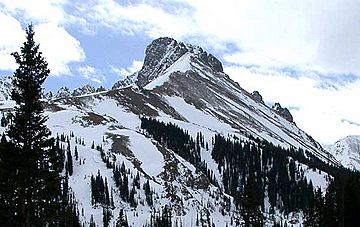Nokhu Crags facts for kids
Quick facts for kids Nokhu Crags |
|
|---|---|

Nokhu Crags, seen from State Highway 14 on the west side of Cameron Pass
|
|
| Highest point | |
| Elevation | 12,490 ft (3,807 m) |
| Prominence | 345 ft (105 m) |
| Geography | |
| Location | Jackson County, Colorado, U.S. |
| Parent range | Never Summer Mountains |
| Topo map | USGS 7.5' topographic map Mount Richthofen, Colorado |
| Geology | |
| Mountain type | Hornfels |
Nokhu Crags is a cool rock formation and mountain in the Never Summer Mountains range, which is part of the Rocky Mountains in North America. Its name comes from the Arapaho language, Neaha-no-xhu, meaning "Eagles Nest."
This impressive peak stands about 12,490-foot (3,807 m) tall. It's located in State Forest State Park, about 2.5 miles (4.0 km) south of Cameron Pass in Jackson County, Colorado, United States. The summit is just northwest of the Continental Divide and Rocky Mountain National Park.
You can easily see Nokhu Crags from State Highway 14. Many people in the southern North Park area know it as "the Crags" or "Sleeping Indian." This is because it looks like a chief lying down to sleep. To the east, you'll find Snow Lake and the Michigan or American Lakes. To the west, the mountain drops steeply into the deep waters of Lake Agnes. To the south, you'll see Static Peak, Mount Richthofen, and the rest of the Never Summer Mountains.
How Nokhu Crags Was Formed
The rocks that make up Nokhu Crags started as sedimentary deposits millions of years ago. Back then, this area was covered by an ancient ocean. Later, the entire region was pushed upwards when the Medicine Bow Mountains formed.
Around 24 to 29 million years ago, hot, melted rock (magma) began to rise. This magma created volcanoes that were the early versions of the Never Summer Mountains. As the magma cooled, it turned into granite. Nearby, shale rock changed into a harder rock called hornfels because of the heat and pressure. This hornfels is what forms the Nokhu Crags we see today.
Over millions of years, erosion (like wind and water wearing away rock) and glaciers (huge sheets of ice) shaped the mountain. They carved out the vertical, fin-like shape of Nokhu Crags. Even today, erosion continues to change the Crags, which is why there's a large field of broken rocks (called a talus field) at its base.
Animals and Environment
Nokhu Crags is mostly barren, meaning it has very few trees or plants. During the day, you might spot small animals like pika and mountain goats moving around on the steep slopes.
In the afternoon, if the light is just right, you can see green and orange colors on the rocks. These colors come from lichen, which are tiny plant-like growths covering the rock face. When evening comes, thousands of bats fly out from cracks and caves on the western side of the mountain.
In winter, Nokhu Crags is covered in deep snow. The sides of the mountain are also a place where avalanches often happen. Avalanches are dangerous, fast-moving slides of snow that can be very powerful.
Historical Names
- Nokhu Crags
- Sawtooth Crags


